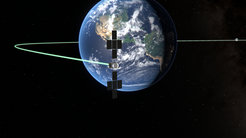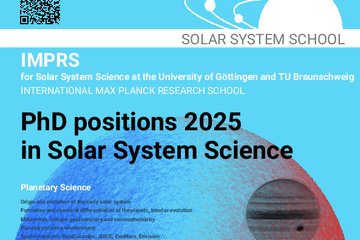JUICE: Preparing for a Double Flyby
Next week, JUICE will pass closely by Moon and Earth. The daring maneuver offers the first opportunity to test the scientific instruments in a Jupiter-like setting.
After almost one and a half years of traveling through space, ESA’s space probe JUICE is due to pay a visit home at the beginning of next week: In order to adjust its speed and course on its way to Jupiter, the space probe will first fly close to the Moon and then to Earth on Monday and Tuesday, August 19 and 20, 2024. This is the first time that a space probe has attempted a maneuver of this kind. The event is eagerly awaited at the Max Planck Institute for Solar System Research (MPS) in Göttingen. The scientific and technical teams that contributed to two of the ten scientific instruments on board have been preparing for months. The unique double flyby offers the first opportunity to carry out measurements under conditions similar to those in the Jovian system.

Since the launch of JUICE in April last year, the space probe's scientific instruments have already been active several times. The so-called checkout windows, short phases lasting several days during which the instruments are switched on, allow for first test runs. “Tests and measurements during the checkout windows are extremely important," explains MPS scientist Dr. Markus Fränz, a member of the PEP-Team. PEP (Particle Environment Package) is one of JUICE’s ten scientific instruments. "They give us a first impression of whether the instrument works as expected and how it performs under real space conditions," he adds. The upcoming maneuver will add a new ingredient (and not just once, but twice): a scientific target in close proximity thus creating a situation that is comparable to the later one in the Jovian system.
Complex choreography in space
In order for JUICE to be captured in the desired orbit by the gas giant when it arrives in the Jupiter system, the speed of the space probe must be exactly right. In the first few years of its eight-year journey, JUICE will therefore fly on a complicated, spiral-like path through the inner solar system and use fly-bys of the Moon, Earth, and Venus to change course, slow down and accelerate - following a precise choreography. It is like work of art, at the end of which the optimum trajectory and speed are achieved. While the upcoming encounters with the Moon and Earth will force the space probe onto a slower course, during the flybys in the coming years JUICE will pick up speed.
Even more remarkable: the planned maneuver will for the first time take a space probe past two celestial bodies at close range. On Monday, August 19, 2024, it will first make a flying visit to the Moon: at 11.16 p.m. (CEST), JUICE will buzz past the Earth's satellite at a distance of just 700 kilometers. Around 24 hours later on Tuesday, 20 August 2024, at 11.57 p.m. (CEST), only 6807 kilometers will separate the space probe from Earth. Even ESA describes the maneuver as a challenge.

Trace gases in the atmosphere
In collaboration with their international partners, the scientific and technical teams at the MPS have been preparing for the double flyby for months. "We used the checkout window in July to rehearse the command sequences for our instrument," reports Dr. Ali Ravanbakhsh, project manager of the SWI team at the MPS. SWI, the Submillimetre Wave Instrument, which was developed and built under the leadership of the MPS, will be active five times for a total of 56 hours from August 19, 2024 during the lunar-Earth flyby. In the Jovian system, the spectrometer will determine, among other things, the molecular composition of the atmospheres of Jupiter and its moons with highest precision. This can, for example, help to answer the question whether all the substances necessary for the development of life are present in the Jovian system.
Measurements of this kind can be practiced during the Earth flyby. SWI will detect dozens of different types of molecules, including four varieties of water vapor that differ in the isotopy of oxygen and hydrogen. Scientists refer to isotopes as variants of the same type of atom that differ only in the number of neutrons in the nucleus. "Determining isotope ratios in the atmosphere of Jupiter is one of the most important goals of SWI," explains Dr. Paul Hartogh, SWI Principal Investigator. This kind can provide clues about the gas giant’s formation and evolution.
Over the next few days, SWI will also measure global temperatures and winds in the Earth's atmosphere. Such observations are also planned for the Jupiter system.
Teamwork with the ARTEMIS probe
The Particle Environment Package (PEP), to which the MPS contributed the Jovian Electron and Ion Sensor (JEI), will also use the flyby for measurements. In the Jovian system, PEP will determine the energy and spatial distribution of charged and uncharged particles in the vicinity of Jupiter and its icy moons. While the upcoming flyby through the Earth's radiation belts will primarily enable calibration measurements in a familiar environment, during the flyby of the Moon, teamwork will be required. JUICE will encounter one of NASA’s two ARTEMIS probes at a distance of only around 3200 kilometers. "This is a very small distance for questions concerning the Moon's plasma environment and enables us to carry out joint calibration measurements with ARTEMIS instruments," explains PEP team member Dr. Elias Roussos from the MPS. The ARTEMIS probe carries instruments on board that are similar to those of PEP. As they have been operating in space for more than a decade and are therefore well known, such joint measurements are particularly valuable.













